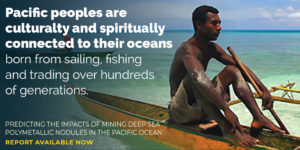New Report highlights Deep Sea Nodule Mining Danger to Pacific Ocean and Island Nations
Executive Summary
Deep sea mining (DSM) in the Pacific is of growing interest to frontier investors, mining companies and some island economies. To date, no commercial operations have been established, but much seabed mineral exploration is occurring. The focus is on polymetallic nodules in the Clarion Clipperton Zone (CCZ) in the north-eastern equatorial Pacific, and in the exclusive economic zones (EEZs) of several nations.
Some stakeholders promote DSM as essential to supply the metals required for a global transition to renewable energy. However, existing terrestrial mineral stocks, progress towards mining of electronic waste, advances towards the development of circular economies, and alternative sources of metals, challenge assertions that the seabed must be mined.
Some companies and governments maintain that future DSM within EEZs will support national prosperity and the development goals of Pacific island economies with little or no negative impact. At the same time, many Pacific islanders express concern about the social, economic and environmental impacts they anticipate deep sea mining would have on their lives. The body of knowledge validating these concerns is slowly growing.

The feasibility and economic benefits of DSM are unsubstantiated. The world’s first licenced deep sea mining project, Solwara 1 in Papua New Guinea (PNG), has had a significant negative economic outcome for that nation. When Nautilus Inc declared bankruptcy, PNG was left burdened by debt, having been persuaded by that company to invest in its failed project. Civil society there and across the Pacific are vocal in their opposition to DSM with calls for a ban in PNG and a moratorium elsewhere in the region.
In 2019, the Intergovernmental Science-Policy Platform on Biodiversity and Ecosystem Services (IPBES) reported on the unparalleled rate of extinction of the world’s biodiversity, with implications for human health, prosperity and long-term survival. The Intergovernmental Panel on Climate Change (IPCC) Special Report on the Ocean and Cryosphere in a Changing Climate has since described the precarious state of marine ecosystems. Yet neither report takes into account the predicted impacts and risks of DSM.
 Deep sea habitats are rich in biodiversity of which only a fraction is known to science. In the Pacific, the little information available on deep seabed habitats relates to the CCZ. Almost nothing is known about the species and diversity of deep sea environments across the rest of the region.
Deep sea habitats are rich in biodiversity of which only a fraction is known to science. In the Pacific, the little information available on deep seabed habitats relates to the CCZ. Almost nothing is known about the species and diversity of deep sea environments across the rest of the region.
This review represents an analysis of literature addressing the predicted and potential impacts of mining deep sea nodules in the Southwest, Central, and Northeast Pacific. More than 250 scientific and other articles were examined to explore what is known — and what remains unknown — about the risks of nodule mining to Pacific Ocean habitats, species, ecosystems and the people who rely on them. The report details scientifically established risks, including those related to the lack of knowledge surrounding this emerging industry.
The accumulated scientific evidence indicates that the impacts of nodule mining in the Pacific Ocean would be extensive, severe and last for generations, causing essentially irreversible damage. Expectations that nodule mining would generate social and economic gains for Pacific island economies are based on conjecture. The impacts of mining on communities and people’s health are uncertain and require rigorous independent studies.



0 Comments